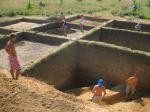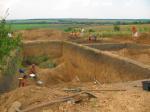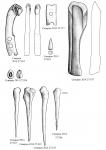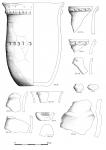Summary (English)
During the season of 2014, the expedition worked on two areas of the hillfort.
Three household pits (№№ 27-29) were explored on the North-Western excavation site. They are distinguished by quite an interesting set of wares. For example, big handmade pots ornamented with a punctured border originated from pit 28. Besides that, a big ladle ornamented with vertical cannelures over his body was found in the same object.
The main attention was paid to the Central excavation site where exploration of the huge complex continued. The researchers dug out an area within 75 m2 but still, they were not able to open the whole object. However, the cross-section of the object was made. It has appeared that for ditches laid NE-SW. The deepest of them was 4.25 m. A quite archaic pot ornamented with rod dimples on his body laid on the bottom of the third layer. The ditches were dumped with sterile clay after that two layers of the coaly soil were deposited over them. Also, several fireplaces were traced under both of the coaly layers.
Numerous artefacts were found within the coaly layers: pots with raised punctured borders, black-glazed ladles, and bowls, zoomorphic clay figurines and miniature vessels. A unique find is a miniature three-nozzled vessel. Many shreds of the storage jars were also decorated with cannelures formed in semicircles. A unique find for this region is a pot decorated with two diametral borders on the rim that make it looks like a face urn. Also, a series of horn products analogous to those from other areas of the hillfort was found here. It is about psalia, decorated in Scythian animal style, arrowheads, pins, as well as shopped horn wastes and semi-finished products. The most interesting are the iron artefacts, namely an unusual bracelet adorned with snake heads at the ends and a rare iron trilobate arrowhead. Besides that, tools of everyday use were also presented here. It is about iron knives and needles, clay spindle whorls and a pair of tools for leather currying and trimming made of animal bones.
All collected material lay within the mid. 7th – mid 6th centuries BC. But the upper coaly layer can be dated more precisely by the second quarter of the 6th c. BC after the find of the only amphora wall fragment, which by the light slip on the outside surface can be attributed to the proto‑Thasian circle.
- Shelekhan Oleksandr - Institute of Archaeology, National Academy of Sciences of Ukraine
Director
- Marcin Ignaczak - Adam Mickiewicz University in Poznan
- Yuriy Boltryk - Institute of Archaeology, National Academy of Sciences of Ukraine
Team
- Oksana Lifantii - National University of Kyiv-Mohyla Academy
- Shelekhan Oleksandr - Institute of Archaeology, National Academy of Sciences of Ukraine
Research Body
- Institute of Archaeology, National Academy of Sciences of Ukraine
- Instytut Prahistorii Uniwersytet im. Adama Mickiewicza w Poznaniu
Funding Body
- National Science Centre (Narodowe Centrum Nauki)





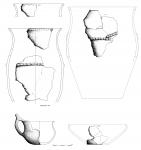
![Download [PDF]](/excavation/skins/fasti/images/results/download_sml.png)
